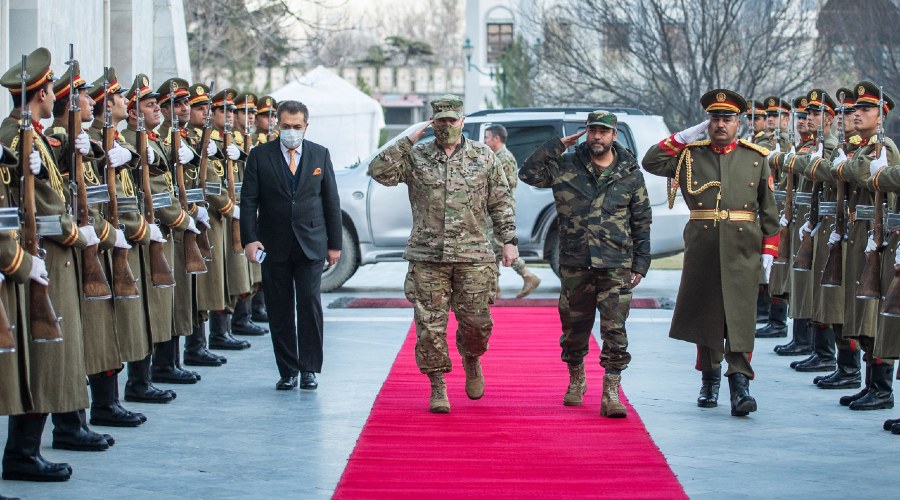Afghanistan Will Be the Biden Administration’s First Foreign Policy Crisis
Four recommendations for the new administration to bolster the Afghan government and security forces.

Published by The Lawfare Institute
in Cooperation With

Editor’s Note: The U.S. war in Afghanistan will continue under its fourth president, but it will not be the same war President-elect Joe Biden dealt with during his time as vice president. The situation on the ground may be even worse, but the Trump administration has initiated a drawdown and made a tentative diplomatic deal with the Taliban. CNA’s Jonathan Schroden assesses the situation in Afghanistan and offers suggestions for the new administration to secure a better peace and a more stable country.
Daniel Byman
***
When President Trump entered the White House in 2016—and when President Obama did the same, eight years prior—the situation in Afghanistan was heading in the wrong direction. Unfortunately, the same will be true again for President-elect Biden. The most recent quarterly report by the Special Inspector General for Afghanistan Reconstruction noted that insurgent attacks from July through September were up 50 percent from the previous quarter and well above seasonal averages. These statements came after its previous quarterly report noted that such attacks from April through June were already “well above historic norms.” While the number of civilian casualties thus far in 2020 has been lower than in the past few years, October was the deadliest month for civilians in Afghanistan since September 2019. The toll on Afghanistan’s security forces has been far greater, however, with more than 10,000 casualties suffered from March through July.
As part of the U.S.-Taliban agreement signed in late February, the Taliban promised to cease attacks against major population areas. In recent months, however, the group has been testing the limits of this promise—for example, in its attacks surrounding Lashkar Gah. It has also expanded violence across the majority of Afghanistan’s provinces and increased attacks against Afghan security force installations. The Taliban have been consolidating their positions in Afghanistan’s rural areas and using them to threaten and capture the areas surrounding the country’s cities in what increasingly looks like a “slow-creeping siege.”
The Trump administration has exacerbated these trends by withdrawing U.S. troops without reciprocal actions by the Taliban, first from 8,600 to 4,500, and more recently via Trump’s rash decision to cut troops to 2,500 by the inauguration. But it will also hand off to the Biden administration an opportunity that didn’t exist previously. Intra-Afghan negotiations between the government of Afghanistan and the Taliban, which began in September, represent the best chance Afghans have had since the Bonn Conference of 2001 to end the cycle of war that has plagued the country for more than 40 years. Despite their initial promise, it took the negotiating teams almost three months to agree on the rules for conducting these talks, and the two sides are now on a 20-day break to discuss each other’s proposals for the agenda of negotiations. These delays, combined with horrific attacks by the Islamic State (such as the recent one at Kabul University) and the Taliban’s nationwide campaign, have diminished hopes that the talks will lead to reductions in violence and suffering of the Afghan people.
President-elect Biden will thus walk into office with a war that is eroding militarily and crawling diplomatically—and he will face a critical decision almost immediately. Per the terms of the U.S.-Taliban agreement, the United States committed to removing all of its troops from Afghanistan by May 1, 2021—just over three months after Biden takes office. Given this situation, what should the Biden administration do? I’ll offer four broad suggestions.
First, play for time. The same part of the U.S.-Taliban deal that requires the full withdrawal of U.S. troops contains the clause “with the commitment and action on the obligations” of the Taliban under the terms of the agreement. Those terms include not cooperating with or hosting individuals threatening the security of the United States and its allies—but the head of al-Qaeda’s franchise in South Asia was recently killed in southern Helmand in a Taliban compound. The agreement also includes several “secret annexes,” which statements by U.S. officials have indicated include clauses about where and how the Taliban are allowed to use violence in the context of its “fight and talk” strategy. The repeated statements by Special Representative for Afghan Reconciliation Zalmay Khalilzad, and the commander of U.S. forces in Afghanistan, Gen. Austin Miller, that the Taliban are violating the “spirit of the agreement” by continuing to increase violence in the areas surrounding the country’s cities make clear that the U.S. does not believe the Taliban are meeting their commitments under the deal. The Biden team should thus prepare a compelling case that the group is not meeting its commitments and that the timeline for completing the withdrawal of all U.S. troops will be paused until such time as the Taliban demonstrate their intent to comply with the deal fully.
Second, the Biden team should let the Taliban know that it has limited patience for the group to demonstrate this intent. Since the signing of the U.S.-Taliban agreement, Afghanistan’s security forces have either been in an “active defense” or “limited offense” posture and the United States has conducted airstrikes only when necessary to defend Afghan army or police positions from Taliban attacks. If the Taliban refuse to reduce violence and move toward compliance with the deal, the Biden administration should begin a graduated—and clearly communicated—set of steps to indicate to the Taliban where the red lines are for its violent activities. These steps should begin with more aggressive actions by Afghanistan’s security forces, starting with its special operations forces and escalating to expanded offensive actions by its army and air force, if necessary. The Taliban have consistently pushed the limits of what the United States will tolerate since the signing of the agreement and have not run into any hard lines from the Trump administration. The Biden team needs to change that dynamic.
Third, the Biden White House should begin preparing for counterterrorism options that do not rely on a U.S. military presence in Afghanistan. Biden has articulated a “difference between large-scale, open-ended deployments of tens of thousands of American combat troops, which must end, and using a few hundred Special Forces soldiers and intelligence assets to support local partners against a common enemy.” Yet, there is significant debate as to whether leaving a small number of U.S. troops in Afghanistan to do this is potentially feasible or impossible relative to the terms of the U.S.-Taliban agreement. Given this uncertainty, the Biden team should develop a range of options for continuing disruption activities against the likes of al-Qaeda and the Islamic State in Afghanistan. These options should, at a minimum, include a U.S. advisory mission to Afghan counterterrorism forces in the country (overt or clandestine); a U.S.-led mission (overt or clandestine) in an adjacent country (Pakistan or a Central Asian state); clandestine support to proxy groups in Afghanistan; and a dedicated offshore platform in the Indian Ocean. I’ve listed these options in order of likely effectiveness, as some of them are decidedly less than optimal, but having a set of hedging options would provide the Biden White House greater freedom of action going forward.
Fourth, the Biden administration should demand a series of reforms of Afghanistan’s security forces. Part of the reason the Taliban have been emboldened is that they see the United States providing less support to the Afghan army and police, and they believe these forces will collapse if and when the United States leaves the country. To counteract that perception and create leverage for the Afghan government in the negotiations, shoring up the country’s security forces is paramount. These reforms should include at least three elements. First, optimization of the Afghan Air Force, which is far too expensive for Afghanistan to sustain and, with a dozen different airframes, is too complex as well. Second, optimization of the Afghan Army, which will have to be simplified to reduce its costs and complexity. Just over a year ago, I attended a Future Force Conference in Kabul that examined a number of options to do this. One option is to consolidate the army’s structure, for example, by reducing the number of corps headquarters and other administrative layers. Another option is to thin the army’s inventory of vehicles, which are expensive to support and contribute greatly to corruption in the form of massive fuel theft. The Biden team should build on that work and enable the army to shift its focus away from fruitless large-scale and reactive operations to enhanced static security of priority areas (for example, those surrounding major cities) that is tailored to the capabilities of the force. Third, the Afghan police desperately need reforms that move it away from a paramilitary model and toward a community policing model. Here, the United States and its NATO allies should leverage existing international police entities (for example, EUROPOL and INTERPOL) and previous lessons from their efforts to engage in substantive police reform efforts.
None of these suggestions will be easy to implement, but they are nonetheless necessary to prevent a quick failure of U.S. policy in Afghanistan—something the incoming Biden administration will be keen to avoid.





